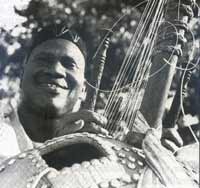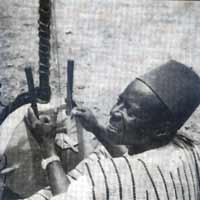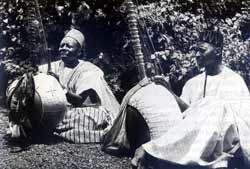 ln
the Mande world, one finds various bridge harps (also called harp-lutes,
which seems less pertinent) such as the donson
n'goni of the Wassoulou hunters and the kamélé
n'goni, a recent instrument derived from it, both of which
are equipped with six strings. In Guinea, they have a bridge harp with
fifteen or nineteen strings: the soron. In Gambia you find the kasso.
The Dan of Côte d'lvoire play the six -or seven- string ko. The Guéré,
also in Côte d'lvoire, use the six-string duu. The sanku is found in
Upper Guinea. The five-to nine- string simbing
is used among the hunters of Gambia as well as among the Mandinka and
Diola of Senegal. Mungo Parks mentions a seven-string variant in Mali.
Bridge harps have also been adopted by some of the populations neighbouring
the Mande world. One can mention the seven-string konchuhun used by
the Gwin in Burkina Faso, the kondene of the Yalunka in Guinea and Sierra
Leone, the Dogon gingiru, along with the six-string kari played by the
Senufo in Côte dlvoire. You can even find a six-string bridge harp called
seperewa among the Ashanti in Ghana. ln
the Mande world, one finds various bridge harps (also called harp-lutes,
which seems less pertinent) such as the donson
n'goni of the Wassoulou hunters and the kamélé
n'goni, a recent instrument derived from it, both of which
are equipped with six strings. In Guinea, they have a bridge harp with
fifteen or nineteen strings: the soron. In Gambia you find the kasso.
The Dan of Côte d'lvoire play the six -or seven- string ko. The Guéré,
also in Côte d'lvoire, use the six-string duu. The sanku is found in
Upper Guinea. The five-to nine- string simbing
is used among the hunters of Gambia as well as among the Mandinka and
Diola of Senegal. Mungo Parks mentions a seven-string variant in Mali.
Bridge harps have also been adopted by some of the populations neighbouring
the Mande world. One can mention the seven-string konchuhun used by
the Gwin in Burkina Faso, the kondene of the Yalunka in Guinea and Sierra
Leone, the Dogon gingiru, along with the six-string kari played by the
Senufo in Côte dlvoire. You can even find a six-string bridge harp called
seperewa among the Ashanti in Ghana.
The
first description of the kora,
the most refined of these harps, can be found in the book by a Scottish
explorer, Mungo Park, who travelled from 1795 to 1797, mainly throughout
what is now Mali. "I must add a list of their music instruments,
the main ones being: the kounting,
a kind of three-string guitar ; the korro,
a large eighteen-string harp ; the simbing,
a small harp with seven strings ; the balafon,
an instrument made of twenty pieces of hard wood, under which are fixed
gourds cut in the shape of a shell to raise the sound; the tang- tang,
a drum open at the lower end; and lastly; the tabala, a large drum generally
used to spread the alarm throughout the country..."
This
korro, which became
kora, is
now commonly equipped with twenty-one strings. It is no doubt relatively
recent (some authors say three-hundred years) since Mungo Park was the
first to describe it, while xylophones had already been observed by
Ibn Battûta, the great Arab traveller who visited the Malian court in
1352.
 It
is thought that the kora
first appeared in what is now Guinea-Bissau, probably associated with
the warrior princes Nyencho from Kabu. Gambia is now renowned for the
quality of its korafolaw (Sidiki Diabaté
and Djelimadi Sissoko, who became
Malian, both originated from Gambia).It is said that the instrument
became popular in the mid-1800s thanks to Koriyang Musa, a disciple
of the legendary Jali
Madi Wuleng, whose jatigui (patron) was the Mandinka hero KeIefa
Same. In its present shape, the kora
usually has twenty-one nylon strings in two parallel rows set on a bridge,
which is perpendicular to the cow-skin soundboard. The latter is tensed
on a half-gourd traversed by a cylindrical sandalwood, or sometimes
mahogany neck. There are two sticks on each side of the neck to hold
the instrument, whose strings are played with the thumb and index fingers
of each hand. A hole, like the sound hole of a violin, is pierced in
the sound box. It is also used for spare strings, and Iisteners gladly
slip bank notes in it to reward the musician. It
is thought that the kora
first appeared in what is now Guinea-Bissau, probably associated with
the warrior princes Nyencho from Kabu. Gambia is now renowned for the
quality of its korafolaw (Sidiki Diabaté
and Djelimadi Sissoko, who became
Malian, both originated from Gambia).It is said that the instrument
became popular in the mid-1800s thanks to Koriyang Musa, a disciple
of the legendary Jali
Madi Wuleng, whose jatigui (patron) was the Mandinka hero KeIefa
Same. In its present shape, the kora
usually has twenty-one nylon strings in two parallel rows set on a bridge,
which is perpendicular to the cow-skin soundboard. The latter is tensed
on a half-gourd traversed by a cylindrical sandalwood, or sometimes
mahogany neck. There are two sticks on each side of the neck to hold
the instrument, whose strings are played with the thumb and index fingers
of each hand. A hole, like the sound hole of a violin, is pierced in
the sound box. It is also used for spare strings, and Iisteners gladly
slip bank notes in it to reward the musician.
The
kora has four main
tunings, all heptatonic. Tomora ba the large tomora, also calIed sila
ba, the large path) is the closest to the western tempered scale : F;
G, A (slightly lower), B flat, C, D, E (slightly lower), F. Two other
tunings can be considered as symmetric variants giving a different colour
from the basic scale (according to Susan Gunn Pevar ). One is hardino
- F, G (slightly lower), A, B flat, C, D (slightly lower), E, F -the
other is tomora mesengo - F; G (slightly higher), A flat (slightly higher),
B flat, C, D (slightly higher), E flat (slightly higher), F. In the
hardino scale, the intervals between the second and third and between
the sixth and seventh degrees are enlarged, while they are shortened
in the tomora mesengo scale. The sauta scale -F; G (slightly lower),
A, B, C, D (slightly lower), E, F is derived from hardino with a transformation
of the fourth into an augmented fourth. According to Roderick Knight
3, "hardino is virtually identical to the western major scale, although
the seventh and the third may be higher than in the latter." Each piece
comprises a main theme, kumbengo, from which the musician makes variations
called birimitingo. The thumbs usually play the bass line while the
index fingers play the melody. In these recordings, tracks 1, 2, 3,
4, 6 and 12 use the sila ba tuning, tracks 8, 10, 11 and 13 are in sauta,
while in tracks 5, 7 and 9, Sidiki Diabaté
is tuned in sila ba and Batourou Sékou Kouyaté
in sauta.
 ln
1977, the Festival d'Automne organized an African programme in Paris,
which notably featured at the 'Cirque d'Hiver' a troupe performing Hira-Gasy,
Madagascar's musical theatre, and the Ekonda ballet ensemble from Zaire,
and the Zairian sanza player Elanga N'Kake at the Bouffes du Nord theatre.
That venue also hosted the concert which was to leave the strongest
mark on Parisian amateurs: the meeting of the two greatest korafolaw
of that time, Sidiki Diabaté and
Batourou Sékou Kouyaté, along with
two djelimoussolou, Mariam Kouyaté
and Wandé Kouyaté. ln
1977, the Festival d'Automne organized an African programme in Paris,
which notably featured at the 'Cirque d'Hiver' a troupe performing Hira-Gasy,
Madagascar's musical theatre, and the Ekonda ballet ensemble from Zaire,
and the Zairian sanza player Elanga N'Kake at the Bouffes du Nord theatre.
That venue also hosted the concert which was to leave the strongest
mark on Parisian amateurs: the meeting of the two greatest korafolaw
of that time, Sidiki Diabaté and
Batourou Sékou Kouyaté, along with
two djelimoussolou, Mariam Kouyaté
and Wandé Kouyaté.
The
astonished audience discovered all together the amazing universe of
court music of extreme refinement, an instrument quasi unknown at that
time (the LP republished here had yet to be released in France) as well
as a people whose mores they knew nothing of. Many Malian workers were
attending. The European public discovered those people whom they saw
daily as garbage men or street sweepers, turned into blood princes who
prodigally distributed their meagre salary to the musicians and singers
celebrating their ancestors, and even their watches or jewellery when
they had no money left. Malian immigration has grown a lot since then
(Montreuil, in the suburbs of Paris, is said to be the third Malian
town in the world). We have become accustomed to hearing kora
players in restaurants or concerts, but we sti11 remain under the charm
of this first meeting with the Mande world, and more particularly that
of the djéliw, the
griots.
These
recordings present the most accomplished expression of their art.
Ancient Strings", the first album totally devoted to the kora,
was first published in 1970.
Henri Lecomte
We wish to thank Jean-Jacques Avenel, and Yakouba Sissoko
Original text of the Long Playing record Première anthologie de la musique
Malienne cordes anciennes
Barenreiter Musicaphon BM 30 L 2505. Mali Music.
Production Ministère de l'information.
The tracks 12 and 13 come from the Long Playing record "The Steppes
and Savannas of Mali The Mandingo."
Barenreiter Musicaphon BM 30 L 2501.
 Batourou
Sékou Kouyaté (Kouyaté:
there is a secret between you and me) and Sidiki
Diabaté (Diabaté: nobody
can refuse you anything) are our best kora-players.
These off springs of the two great families of griots
(poets) of Mali perpetuate a secular art. Our public opinion polls have
shown that one cannot love the one without the other. But one can say
that Batourou Sékou, who expresses
himself in the Mandeka style, is more intellectual, more airy. Batourou
Sékou Kouyaté (Kouyaté:
there is a secret between you and me) and Sidiki
Diabaté (Diabaté: nobody
can refuse you anything) are our best kora-players.
These off springs of the two great families of griots
(poets) of Mali perpetuate a secular art. Our public opinion polls have
shown that one cannot love the one without the other. But one can say
that Batourou Sékou, who expresses
himself in the Mandeka style, is more intellectual, more airy.
The music of Sidiki Diabaté, the
bard from the Kanbia country, on the other band, animates the blood.
The one ad dresses himself to the mind, the other to the body. At the
time when the epic poems of Sunjata, Da Monzon, El Hadji Omar (Omar
al-Haj), and Samory were written, a time of recon quests, Sidiki
Diabaté would have followed the warriors to the battle-field
and, in the evenings, Batourou Sékou Kouyaté
would have given them more courage.
Mali
: Ancient Strings
Koras : Sidiki Diabaté, Batourou Sékou Kouyaté, Djelimadi Sissoko, N'Fa
Diabaté
Collection Music from the World
Production Ministère de l'Information du Mali Licence Syllart Production
Distribution BUDA Records 1977822
Photos : (D.R.) Marcel Thuillier
www.budamusique.com
buda @ imaginet dot fr |
 ln
the Mande world, one finds various bridge harps (also called harp-lutes,
which seems less pertinent) such as the
ln
the Mande world, one finds various bridge harps (also called harp-lutes,
which seems less pertinent) such as the  It
is thought that the
It
is thought that the  ln
1977, the Festival d'Automne organized an African programme in Paris,
which notably featured at the 'Cirque d'Hiver' a troupe performing Hira-Gasy,
Madagascar's musical theatre, and the Ekonda ballet ensemble from Zaire,
and the Zairian sanza player Elanga N'Kake at the Bouffes du Nord theatre.
That venue also hosted the concert which was to leave the strongest
mark on Parisian amateurs: the meeting of the two greatest
ln
1977, the Festival d'Automne organized an African programme in Paris,
which notably featured at the 'Cirque d'Hiver' a troupe performing Hira-Gasy,
Madagascar's musical theatre, and the Ekonda ballet ensemble from Zaire,
and the Zairian sanza player Elanga N'Kake at the Bouffes du Nord theatre.
That venue also hosted the concert which was to leave the strongest
mark on Parisian amateurs: the meeting of the two greatest  Batourou
Sékou Kouyaté (Kouyaté:
there is a secret between you and me) and Sidiki
Diabaté (Diabaté: nobody
can refuse you anything) are our best
Batourou
Sékou Kouyaté (Kouyaté:
there is a secret between you and me) and Sidiki
Diabaté (Diabaté: nobody
can refuse you anything) are our best